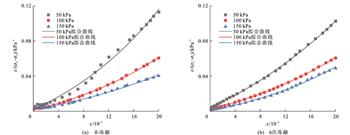| 冻融循环条件下盐渍化风积沙力学特性 |
| |
| 引用本文: | 包卫星, 李伟, 毛雪松, 陈锐, 秦川, 刘亚伦. 冻融循环条件下盐渍化风积沙力学特性[J]. 交通运输工程学报, 2023, 23(6): 114-124. doi: 10.19818/j.cnki.1671-1637.2023.06.005 |
| |
| 作者姓名: | 包卫星 李伟 毛雪松 陈锐 秦川 刘亚伦 |
| |
| 作者单位: | 长安大学 公路学院,陕西 西安 710064 |
| |
| 基金项目: | 国家自然科学基金项目51878064 新疆维吾尔自治区重大科技专项项目2020A03003-7 陕西省自然科学基础研究计划项目2021JM-180 中央高校基本科研业务费专项资金项目300102211302 |
| |
| 摘 要: | 
为研究季冻区沙漠边缘盐渍化风积沙力学特性,在冻融循环条件下对不同含盐量风积沙开展了三轴不固结不排水剪切试验,为研究冻融循环后不同含盐量风积沙应力-应变关系曲线与抗剪强度的劣化规律,提出了一种考虑围压与冻融循环次数条件下修正的邓肯-张模型,并引入抗剪强度劣化度描述风积沙强度衰减速度,提出了冻融循环次数与含盐量对风积沙抗剪强度的耦合作用计算公式。研究结果表明:不同冻融循环次数、含盐量与围压下风积沙应力-应变曲线均表现为应变软化型,冻融循环状态下的盐渍化风积沙受到温度与盐分的耦合作用,随着冻融循环次数与含盐量的增加,风积沙应变软化速率显著降低;修正的邓肯-张模型可以较好地描述风积沙应变软化特征,不同冻融循环次数下风积沙初始回弹模量随围压增大而增大,随冻融循环次数增加先减小后缓慢增加;在冻融条件下,无盐风积沙抗剪强度劣化速率较慢,而对于含盐风积沙,土中的盐分与水分相变加快了风积沙抗剪强度的劣化速率,使得风积沙抗剪强度迅速降低;对于不同围压下的风积沙,其强度变化规律相似,即在经历初次冻融循环后抗剪强度显著下降,并随着冻融循环次数的增加,强度劣化速率逐渐趋于稳定,风积沙抗剪强度劣化度随冻融循环次数增加呈双曲线递增,随含盐量的增大呈线性递增趋势。

|
| 关 键 词: | 路基工程 风积沙 三轴试验 冻融循环 含盐量 应力-应变 劣化模型 |
| 收稿时间: | 2023-06-27 |
|
| 点击此处可从《交通运输工程学报》浏览原始摘要信息 |
|
点击此处可从《交通运输工程学报》下载免费的PDF全文 |
|


